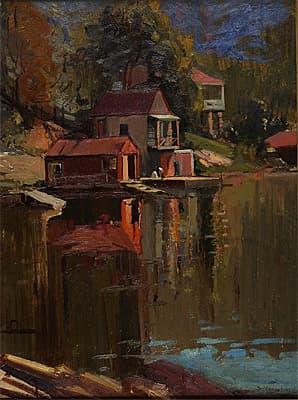Sydney
LONG
Australia
1871
–
London
1955
England, Europe 1910-21; Australia 1921- 22; England 1922-25; Australia 1925-52; England from 1952
61.1 (h) x 45.5 (w) cm
signed ‘Sydney Long’ lower right New England Regional Art Museum, Armidale, gift of Howard Hinton 1945
Oatley Bay is an image of boatsheds with steep A-line roofs on the shore of the Georges River. There are three people working on the jetty that juts out in front of the boatsheds. The lower part of the image consists of water, with sparkling reflections. A sloping hill with trees and bushes rises up behind the buildings, under a bright blue sky. There is a calm, sunny atmosphere to the scene.
The subject is the bay at the railway bridge where the Woronora River meets the Georges River, Kogarah, which is a popular area for boating, fishing, picnicking and bushwalking.
Long most likely painted Oatley Bay soon after his return to Australia in 1925. The intense opposing colours – reds, oranges, khaki green and blue – and the thickly applied paint with the broadly brushed areas of flat colour, differ from much of his work. Likewise, the subject of buildings and an almost formalist composition are unusual for Long. Nonetheless, in 1921 he told
A.G. Stephens ‘we are trying to get back to Form as the foundation of Colour’ (Stephens, 1921). In these aspects, Oatley Bay resembles Long’s in Street scene, Kandy (cat 61). In painting these two works, Long may have been influenced by the use of opulent colour and painterly approach of the British painter–etcher Frank Brangwyn, with whom he associated in London in the early 1920s.
Oatley Bay is an image of boatsheds with steep A-line roofs on the shore of the Georges River. There are three people working on the jetty that juts out in front of the boatsheds. The lower part of the image consists of water, with sparkling reflections. A sloping hill with trees and bushes rises up behind the buildings, under a bright blue sky. There is a calm, sunny atmosphere to the scene.
The subject is the bay at the railway bridge where the Woronora River meets the Georges River, Kogarah, which is a popular area for boating, fishing, picnicking and bushwalking.
Long most likely painted Oatley Bay soon after his return to Australia in 1925. The intense opposing colours – reds, oranges, khaki green and blue – and the thickly applied paint with the broadly brushed areas of flat colour, differ from much of his work. Likewise, the subject of buildings and an almost formalist composition are unusual for Long. Nonetheless, in 1921 he told
A.G. Stephens ‘we are trying to get back to Form as the foundation of Colour’ (Stephens, 1921). In these aspects, Oatley Bay resembles Long’s in Street scene, Kandy (cat 61). In painting these two works, Long may have been influenced by the use of opulent colour and painterly approach of the British painter–etcher Frank Brangwyn, with whom he associated in London in the early 1920s.
Oatley Bay is an image of boatsheds with steep A-line roofs on the shore of the Georges River. There are three people working on the jetty that juts out in front of the boatsheds. The lower part of the image consists of water, with sparkling reflections. A sloping hill with trees and bushes rises up behind the buildings, under a bright blue sky. There is a calm, sunny atmosphere to the scene.
The subject is the bay at the railway bridge where the Woronora River meets the Georges River, Kogarah, which is a popular area for boating, fishing, picnicking and bushwalking.
Long most likely painted Oatley Bay soon after his return to Australia in 1925. The intense opposing colours – reds, oranges, khaki green and blue – and the thickly applied paint with the broadly brushed areas of flat colour, differ from much of his work. Likewise, the subject of buildings and an almost formalist composition are unusual for Long. Nonetheless, in 1921 he told
A.G. Stephens ‘we are trying to get back to Form as the foundation of Colour’ (Stephens, 1921). In these aspects, Oatley Bay resembles Long’s in Street scene, Kandy (cat 61). In painting these two works, Long may have been influenced by the use of opulent colour and painterly approach of the British painter–etcher Frank Brangwyn, with whom he associated in London in the early 1920s.

